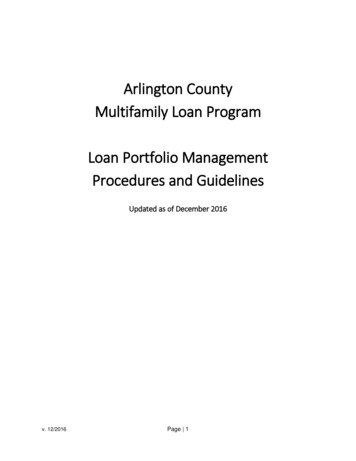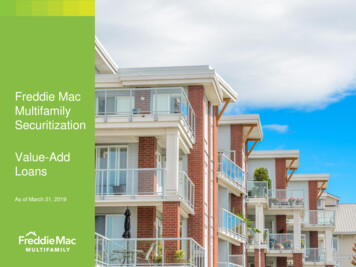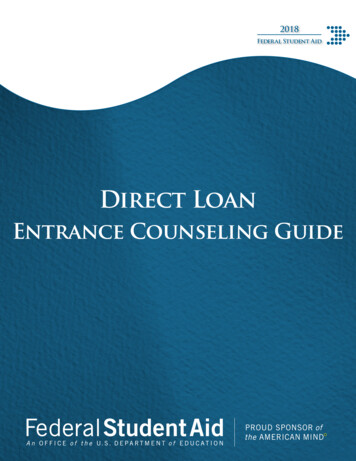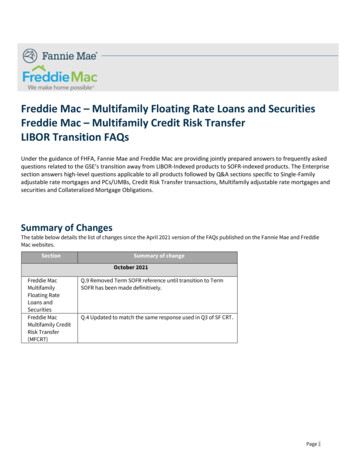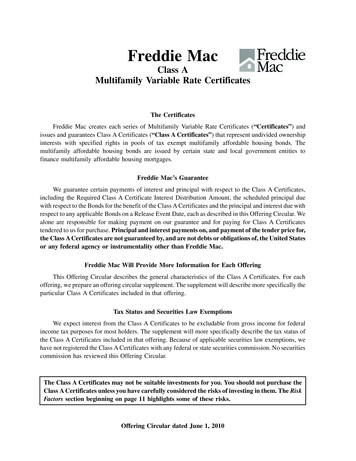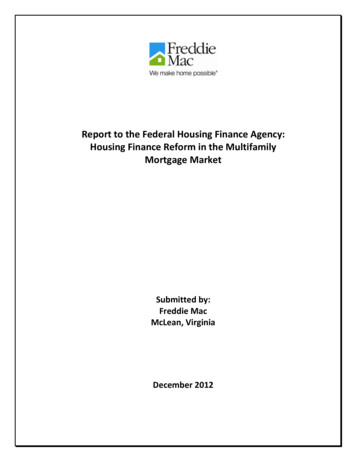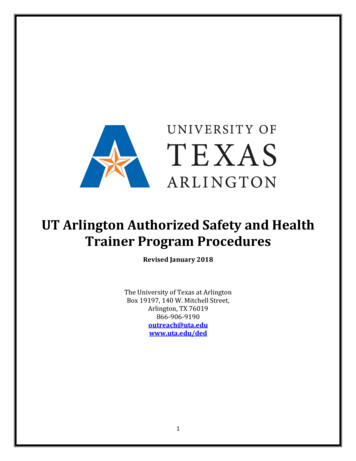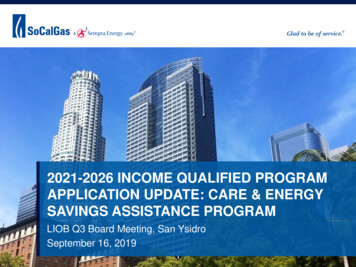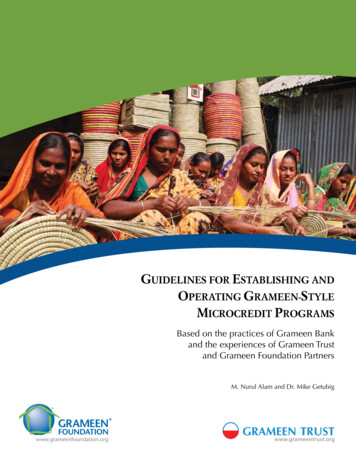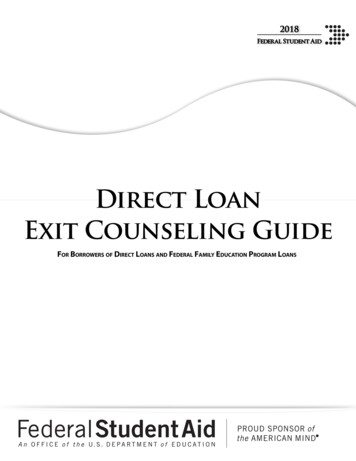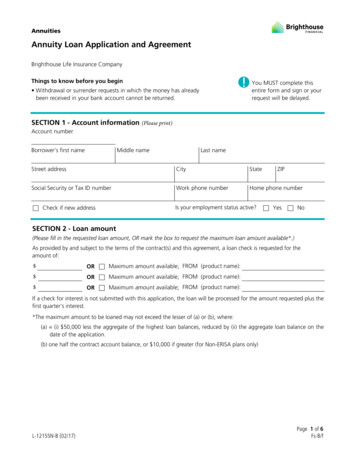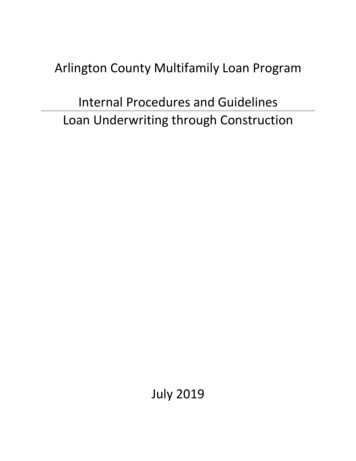
Transcription
Arlington County Multifamily Loan ProgramInternal Procedures and GuidelinesLoan Underwriting through ConstructionJuly 2019
Arlington County Multifamily Loan ProgramInternal Procedures and GuidelinesLoan Underwriting through ConstructionI.Introductiona. Scope of Documentb. Affordable Housing Master Plan Goals, Objectives and Policiesc. Program Mission and Goalsd. Funding Sources – AHIF, HOME, CDBGe. NOFA ProcessII.Loan Underwriting and Project Reviewa. Sources of Funds and Financing Structureb. Uses of Funds and Capital Budgetc. Operating Budgetd. Calculating the Loan Amount (Filling the Gap)e. County Loan Termsf. Additional Project Considerationsi. Federal Reviewii. Tenant Relocationiii. Tenant Assistance Fundg. Multifamily Loan Advisory GroupIII.Community and County Board Approval Processa. Housing Commissionb. Community Development Citizens Advisory Commission (CDCAC)c. Site Plan Review Committee (SPRC) and Planning Commissiond. Form Based Code Advisory Working Group (FBC AWG)e. Historical Affairs and Landmark Review Board (HALRB)f. Tenant‐Landlord Commissiong. County BoardIV.Loan Documents and Closinga. Building Permitsb. Drafting and Approval of County Loan Documentsc. Closing Calls and Coordinationd. Pre‐Disbursement and Closing Conditionse. Closing Draw Reviewf. Closing
g. Loan Filingh. ATRACKV.Construction through Completiona. Construction Drawsb. Construction Progressc. Construction Completion and Certificates of OccupancyExhibit 1: Affordable Housing Goals, Objectives and Policies of the Affordable Housing Master PlanExhibit 2: NOFA FY 2020 Scoring GuidanceExhibit 3: Criteria for Determining Commission ReviewExhibit 4: Business and Legal Provisions of County Multifamily Loan AgreementsExhibit 5: Sample County Closing ChecklistExhibit 6: Sample County Closing Instruction Letter
I. INTRODUCTIONScope of DocumentThis document describes internal procedures and guidelines for Arlington’s multifamily loanprogram, from the time of underwriting through construction completion. These proceduresand guidelines primarily outline the work of the Development Specialists on the HousingDivision’s Development Team. The Development Specialist assigned to a project serves as the“Project Lead” from the time of loan underwriting through construction completion.A companion document, Loan Portfolio Management Procedures and Guidelines, primarilyoutlines the work of the Housing Division’s Finance and Asset Management Team (FAM). TheFAM Team takes over the financial management of loans and the asset management of theprojects upon construction completion.Affordable Housing Master Plan Goals, Objectives and PoliciesIn September 2015, the Arlington County Board adopted the Affordable Housing Master Plan(AHMP) which is an element of the Arlington County Comprehensive Plan. The AHMP wasdeveloped as the County’s long‐range vision for addressing housing needs through 2040, anddefines the County’s housing policy. The AHMP will be reviewed and revised as necessary at leastonce every five years to account for changing conditions within and beyond the County.The Affordable Housing Goals and Objectives are used for guidance as the County invests itsAffordable Housing Investment Fund (AHIF), Home Investment Partnerships Program (HOME)and Community Development Block Grant (CDBG) funds in housing projects that containcommitted affordable units (CAFs). The Affordable Housing Goals, Objectives and Policies of theAffordable Housing Master Plan are listed in Exhibit 1.Program Mission and GoalsThe AHIF is the County’s main financing program for affordable housing development. Since itscreation in 1988, AHIF has helped to create the majority of Arlington’s more than 8,000approved affordable rental units that benefit low‐ and moderate‐income households. Thisrevolving loan fund provides incentives for developers through low‐interest loans for newconstruction, acquisition and rehabilitation of affordable housing. Between 1988 and 2018, theCounty originated more than 340 million in loans for affordable units.As stated in the adopted AHMP, the County policies for AHIF are as follows: 1.1.1 Encourage the construction and preservation of affordable rental housing throughland use/zoning policy, financial and technical assistance.1.2.2 Encourage production and preservation of family‐sized (e.g. 3 bedroom)moderately‐priced ownership units.1
2.5.3 Maintain a sufficient supply of committed affordable housing that is accessible topersons with physical and sensory disabilities.3.4.2 Ensure financial feasibility in the underwriting of County loans for affordablehousing.Funding Sources – AHIF, HOME, CDBGThe AHIF is a fund that provides gap financing to developers that preserve or build CAFs in theCounty. AHIF is the key mechanism through which the County funds the construction andredevelopment of housing affordable to low‐income renters. AHIF also supports housing thatcombines housing and services for vulnerable populations. In addition to AHIF funds, the Countyreceives federal CDBG and HOME funds which are also used for multifamily loans.AHIF is funded by several sources: developer contributions obtained through the AffordableHousing Ordinance; general fund appropriations; AHIF loan repayments; and a portion ofproperty recordation fees. Between FY2010 and FY2018, AHIF received an average of 9.8million in local funding annually.Notice of Funding Availability (NOFA) ProcessIn Fiscal Year 2018 the County initiated a new process, a NOFA, for evaluating multifamily loanrequests and making recommendations for the fiscal year’s pipeline. In contrast to the previousrolling application process, the NOFA allows Housing Division staff to evaluate projectsconcurrently and rank projects by comparing them on select criteria. The rankings form the staffrecommendations for the following fiscal year’s pipeline. The recommendations are not acommitment of funds. It is a staff recommendation to continue the negotiations and publicprocess.As described more thoroughly in Exhibit 2, the NOFA Scoring Guidance, the NOFA scoringprocess is comprehensive. Staff analyzes the project against many competing goals andobjectives such as the AHMP Goals, project risk and opportunity, project readiness andschedule, capital budget standards, proforma and operating budget standards, anddeveloper/sponsor experience.The County’s Housing Division conducts an administrative process to determine the NOFArankings. The Housing Development, FAM, and Planning and Community Development (PCD)teams score appropriate sections of the applications. The scores are then totaled and averagedacross all staff into a final score. Housing staff then presents the recommendations for thepipeline to the County Manager’s Office. The recommended applicants are notified and staffmeets and debriefs with all applicants who request feedback. There is not an appeals process.After a positive recommendation, applicants then continue the four‐ to eight‐month loanunderwriting process, which includes negotiations with the developer/owner on the financing,and the community process, which includes meetings with various County Board advisorycommissions. At the conclusion of the review process, staff makes a recommendation to the2
County Board for an allocation of County loan funds.Upon the completion of the NOFA process, each successful project is assigned a Project Lead toserve as the project manager from the time of underwriting through construction completion.Sections II and III on the following pages describe the loan underwriting and communityprocesses, culminating in County Board consideration. Section IV details development of loandocuments and loan closing. The final part, Section V, discusses construction draws throughcompletion.3
II. LOAN UNDERWRITING AND PROJECTREVIEWThe goal of the loan underwriting and project review process is to ensure that the projectconforms with the stated affordable housing policies and objectives of the AHMP, meets thecriteria of the NOFA Scoring Guidance, and utilizes the minimum allocation from the County toaccomplish the goals. The following sections speak broadly to the loan underwriting process,while Exhibit 2—the NOFA Scoring Guidance—provides the County’s detailed current loanunderwriting criteria. The final sections discuss additional project considerations, whenapplicable, such as the Federal review for CDBG and HOME funds, tenant relocation, and tenantassistance funds.Sources of Funds and Financing StructureThe County’s loan funds are leveraged in each multifamily development project by otherfinancing sources, including but not limited to a senior loan, Low Income Housing Tax Credit(LIHTC) equity, developer contribution, and deferred developer fee. The County’s loan issubordinate in payment and lien priority to that of the senior lender.Developers obtain a senior loan for the highest amount for which the project can qualify. Thefinal loan amount is dependent on the project’s calculated net operating income (NOI), currentinterest rates, and the senior lender’s underwriting requirements, such as debt coverage ratios.At the time of the County loan application, often up to a year before loan closing, the developermust estimate the senior loan amount based upon reasonable assumptions and interest ratebuffers.Almost all County projects—except acquisition‐only projects—are also LIHTC projects. With aLIHTC project, an investor provides equity to the project in exchange for ten years of tax creditsagainst their federal tax liability. The investors’ tax credit pricing is dependent on market factorsand specifics of the deal, such as timing of equity pay‐ins.There are two LIHTC programs: the competitive 9% program and the non‐competitive 4%program, the latter which must be coupled with tax‐exempt bond financing. The competitive 9%LIHTC program yields approximately twice the amount of tax credits, and resulting equity, as the4% LIHTC program. For this reason, the financing gap and resulting County investment is lowerper unit for 9% LIHTC projects. The 9% program, however, is highly competitive and not as wellsuited for some types of projects, such as rehabilitation.While 9% tax credits and 4% tax credits can’t be combined in the same project, a trend since2015 has been to create a hybrid 9%/4% deal. With the hybrid structure, there are two projectsowned by two separate tax credit partnerships and financed separately.4
The developer’s financing plan should be sound, reasonable, and creative. It should include othernon‐County sources, such as discounted land, or funds from the Federal Home Loan BankAffordable Housing Program or the Virginia Housing Trust Fund.The Project Lead’s role is to analyze the proposed financing structure to determine if it is theappropriate one, or if other structures should be considered. In addition, the Project Leadverifies that the developer is using reasonable assumptions and that all financing is calculatedaccurately.Uses of Funds and Capital BudgetThe developer’s proposed capital budget should be clear, accurate, and thorough. A capitalbudget is composed of: acquisition costs; construction costs; soft costs (such as architect,engineering, legal, and permitting fees); financing costs; reserves; and the developer’s fee.The Project Lead’s role is to examine if acquisition costs are at or below the appraised value,construction costs are reasonable and supported by contractor estimates, and fees and softcosts are reasonable. If the project is requesting or being recommended for Federal funds, thebudget should include appropriate associated costs related to Davis‐Bacon labor wages,environmental review, the Uniform Relocation Act (URA), and other costs applicable to federalfunding.Operating BudgetThe developer must include a 30‐year proforma, which includes annual projections on income,operating expenses, debt service, priority payment fees, and cash flow payments to the County.A Year 15 plan/exit analysis is included if tax credits are being utilized.The Project Lead ensures that income projections are consistent with rents for targetedhouseholds, vacancy rates and other income are reasonable, and operating costs andreplacement reserves are consistent with other developments. Priority payment fees, or thosepaid in advance of the County/developer’s cash flow split, should not exceed the amountspecified in the NOFA Scoring Guidance. Priority payment fees often include some combinationof asset management fees, investor services fees, and/or resident services fees.Calculating the Loan Amount (Filling the Gap)The Project Lead must analyze all the elements described in this chapter—financing structureand sources, capital budget, and operating budget—to calculate the recommended County loanamount. Staff must ensure that the amount of County funds recommended is truly gapfinancing, without which the project could not go forward. The loan underwriting process isiterative and often involves multiple updates to the financial assumptions. The Project Lead’srole is to recommend a loan amount based on the outcomes of the underwriting process. Theprocess involves negotiations as the developer may be resistant to making the financial changesrecommended by the Project Lead.5
County Loan TermsThe County’s loans are usually structured as cash flow or “residual receipts” loans. The loans aretypically 30 years or more, with a below‐market interest rate. The developer provides an annualpayment to the County based on a portion of residual receipts. Residual receipts are generallydefined as the gross revenues minus the sum of the senior lender debt service payments,approved operating expenses, property management fee, and any approved priority paymentfees in each fiscal year. The balance of the County loan is due at the end of the term or upon saleor transfer of the property, unless it is refinanced or redeveloped with County Board approvaland retains its affordability.Additional Project ConsiderationsThis section discusses additional considerations, which may or may not be applicable to a givenproject, including: Federal review for CDBG and HOME funds; tenant relocation; and tenantassistance funds.Federal Compliance ReviewFor projects utilizing CDBG or HOME funds, there is an additional Federal compliance reviewprocess that is conducted concurrently with the loan underwriting process. The CommunityDevelopment (CD) staff of the PCD Team of the Housing Division take the lead on the Federalreview.The Federal compliance review takes into consideration several applicable Federal requirementsdepending on the scope and type of project being undertaken. Federal requirements can includeminority / women business outreach, labor standards, equal opportunity, fair housing standards,affirmative marketing, housing accessibility standards, uniform relocation standards,environmental review, site and neighborhood standards and lead‐based paint compliance. ForHOME projects, the review also consists of a subsidy layering analysis conducted by CD and FAMstaff. The review must be completed in advance of the County Board allocation request.Tenant RelocationSome projects funded by the County’s multifamily loan funds involve relocation of some or allexisting tenants due to renovation, demolition and new construction, or new affordabilityrestrictions. The County’s Relocation Guidelines were established to set standards and provideadministrative guidance for owners assisting tenants facing displacement. Owners proposingprojects which require County Board approval (i.e. County multifamily loans, site plans, usepermits, etc.) require adherence to the Guidelines. Relocation Plans are required for any projectsubject to the Virginia Residential Landlord and Tenant Act which results in tenant displacement.The Relocation Coordinator on the PCD Team leads the review and approval of Relocation Plansand adherence to the County’s Relocation Guidelines. A draft Relocation Plan is due to theRelocation Coordinator at least four months before a developer plans to issue 120‐day Noticesto Vacate to the tenants. This is often months or years past the time of County Board allocation6
of loan funds. Following input from staff and the Tenant‐Landlord Commission, the CountyManager approves the final Relocation Plan.Tenant Assistance Fund (TAF)TAFs provide rent assistance to qualified households who might be displaced during a projectinvolving CAFs. TAFs are available to qualified tenants whenever redevelopment, renovation, oracquisition, as part of a CAF project, results in increased rents. If a project is eligible for a TAF,the Project Lead works with the Compliance Officer on the FAM Team to project the amount ofCounty funds needed for the TAF. The Compliance Officer works closely with the developer toobtain information on current households and to determine the number of eligible households.A request of AHIF funds for a TAF is made in conjunction with the County loan request to theCounty Board.Multifamily Loan Advisory Group (MLAG)The MLAG was established in 2018 as an inter‐departmental advisory group to reviewmultifamily loan recommendations in advance of the County Manager’s consideration. TheMLAG is structured with the following participation, roles, and responsibilities: CPHD Housing Division project staff – Lead role; set agenda and provide materials inadvance of meetings. Responsible for preparing all materials, organizing and facilitatingmeetings, and setting agendas.Department of Management and Finance (DMF) staff – Advisory role; review staffmaterial and offer suggestions consistent with overall County financial perspective.County Attorney’s Office (CAO) Assistant County Attorney(s) – Advisory role; review staffmaterial and offer suggestions from County legal perspective.Department of Human Services (DHS) staff –Advisory role; review staff material and offersuggestions from County policy perspective (e.g., impacts on housing grants, supportivehousing, and other complementary programs).Department of Environmental Services (DES) staff – Advisory role; review staff materialand offer suggestions from the perspective of sustainability.The MLAG works as a collaborative committee with the Housing Division staff who formulate thefunding recommendations to go to the County Manager. The group meets following the NOFAprocess (or upon receipt of a funding application for an out‐of‐cycle, unrelated third‐partymarket acquisition) and again, as needed, before Housing Division staff finalize fundingrecommendations for projects.7
III. COMMUNITY AND COUNTY BOARDAPPROVAL PROCESSThe community process often takes place on a parallel timeframe to the loan underwriting andnegotiation process. During the community process, the project will be presented to variousCommissions—dependent on the project specifics—related to housing, federal funds, planning,historic review, and tenant relocation. Following a comprehensive community review, theCounty Board will consider approval of the County loan. The following sections discuss thepurview of the various Commissions, each of which are advisory bodies to the County Board, andthen the County Board approval process. Exhibit 3 provides bulleted criteria for determiningwhich Commissions must review a given project.Housing CommissionAll projects seeking County multifamily loan funds must be presented to the HousingCommission for consideration. The Housing Commission is responsible for advising the CountyBoard on housing policy issues and funding allocations. The Project Lead must request that theproject be placed on the Housing Commission agenda for two meetings, the first for aninformational item and the second for an action item, both in advance of the County Boardmeeting.At the first Commission meeting, the Project Lead and the developer applicant will each presentan overview of the project and funding request. This is an opportunity for Commissioners tolearn the basics of the project, such as location, type and general scope of project, affordabilityprogram, and funding request. It is also an opportunity for Commissioners to ask questions andprovide input on the proposal.In between the first and second Housing Commission meeting, the Project Lead works with theHousing Commission chair to schedule a Bricks and Mortar subcommittee meeting to beattended by the Project Lead and developer applicant. The purpose of the subcommitteemeeting is to review the detailed financials of the project, including the budget and projectedCounty loan repayment schedule. The subcommittee votes to make a recommendation that willbe presented to the full Housing Commission at its second meeting.At the second full Housing Commission meeting, the Project Lead and the developer applicanteach present the project again. The developer applicant emphasizes changes made since theinformational item, including those requested by Commissioners, and answers any outstandingquestions. The Project Lead presents the County staff’s recommendation on the project,including funding level and loan terms. The Bricks and Mortar subcommittee reports out on itsmeeting. The Housing Commission votes on the project and sends a letter to the County Board.A member of the Housing Commission often presents the vote and answers questions at theCounty Board meeting.8
Community Development Citizens Advisory Commission (CDCAC)CDCAC reviews grant and loan requests, evaluates programs and makes recommendations tothe County Board for the use of federal CDBG, HOME, and Community Services Block Grant(CSBG) funds. CDCAC also advises on the development of Arlington’s five‐year Consolidated Planand the Annual Action Plans to the Department of Housing and Urban Development (HUD). TheAnnual Action Plan describes the County’s planned uses for CDBG and HOME funds. Since someof the County’s multifamily loans are comprised of CDBG and/or HOME funds, projects thatpropose to use either source must be reviewed by CDCAC.The Project Lead must request that the project be placed on the agenda of one CDCAC meetingin advance of the County Board meeting, preferably the same month as the HousingCommission informational item. Similar to the Housing Commission meeting presentation, theProject Lead presents the basics of the project, including location, type and general scope ofproject, affordability program, and funding request. Unlike the Housing Commission meetings,the developer applicant does not need to attend. CDCAC votes to make a recommendation andsends a letter to the County Board on the federal funding request.Site Plan Review Committee (SPRC) and Planning CommissionSpecial exception site plan (“site plan”) applications allow for site‐specific flexibility indevelopment form, use, and density, beyond what is otherwise permitted by‐right via the ZoningOrdinance. Most significant private and public‐private projects in Arlington are developedthrough a site plan process that ensures proper reviews, public processes and compliance withapplicable policies and ordinances.The SPRC is a subcommittee of the Planning Commission which meets to discuss each site planapplication over typically three or more meetings. The SPRC includes members of the PlanningCommission, other County Commissions, impacted Civic Association, and impactedpublic/private revitalization organizations. The meetings focus on land use and zoning, designand architecture, transportation, open space, and community benefits. The SPRC meetings aimto resolve site plan issues before proposals go to public hearings of the Planning Commissionand County Board.A portion of the projects funded by the County’s multifamily loan funds are site plan projects. Inthe past, the loan underwriting and site plan processes typically ran concurrently, culminating inone County Board meeting for both the site plan and County loan request. Since 2016, severalaffordable housing projects have opted to go through the site plan process and receive site planapproval in advance of the NOFA process for County loan funds. If a Project Lead has beenassigned in advance of the planning process, then he/she can attend one or more SPRCmeetings to stay apprised of the main site plan issues.Site plans ultimately are heard by the Planning Commission in an advertised public hearing withpublic testimony. The Planning Commission then votes whether or not to recommend approvalof the site plan to the County Board.9
Form Based Code Advisory Working Group (FBC AWG)The FBC AWG includes members from civic associations, Columbia Pike RevitalizationOrganization (CPRO), several advisory Commissions, developers, and the Zoning Committee ofthe Planning Commission (ZOCO). The FBC AWG reviews each project within the Columbia PikeForm Based Code (FBC) and the Neighborhoods Form Based Code (N‐FBC) for compliance withthe applicable code.A subset of the projects funded by the County’s multifamily loan funds are Form Based Codeprojects. It is recommended that the Project Lead attend the AWG meeting to become familiarwith any issues that are discussed. Unlike the multiple SPRC meetings, there is typically one AWGmeeting per project.Historical Affairs and Landmark Review Board (HALRB)The Historical Affairs and Landmark Review Board (HALRB) advises the County Board on historicpreservation matters. The HALRB nominates properties for local and national designation andalso reviews plans for exterior alterations, demolition and new construction in locally‐designatedArlington Historic Districts through a Certificate of Appropriateness (CoA) process. The CoAapplicants must first go before the Design Review Committee (DRC) – a subcommittee thatworks with the HALRB. The DRC offers free technical and design advice to the applicant andhelps finalize the CoA request before it goes to the HALRB for review.In several incidences, projects funded by County multifamily loan funds would need to be heardby the HALRB. This includes projects needing a CoA in a locally‐designated Arlington HistoricDstrict, projects with properties listed as Essential or Important on the Historic ResourcesInventory (HRI), or projects with properties recommended for preservation in a County Board‐adopted plan or policy document.Tenant‐Landlord CommissionThe Tenant‐Landlord Commission advises the County Board on policy and programs, reviewsRelocation Plans, and proposes legislation for the County Board’s recommendation to theGeneral Assembly. The Commission includes representatives from each of the following groups:tenants, landlords and public interest (homeowners who do not own rental property).Some projects funded by the County’s multifamily loan funds will involve temporary orpermanent relocation of existing tenants. In advance of the County Board’s consideration ofloan funds, the Relocation Coordinator of the PCD Team provides an overview of these projectsto the Tenant‐Landlord Commission. If the Commission requests a full information item on theproject, then the Project Lead, Relocation Coordinator and the developer applicant willcoordinate attendance.The Tenant‐Landlord Commission reviews a Relocation Plan in advance of the developer’sissuance of 120‐day Notices to Vacate in order to make a recommendation to staff for approval.Depending on the project timeline, review of the Relocation Plan often takes place months or10
even years post County Board approval of the loan funds. At that time, the RelocationCoordinator works with the developer to schedule two Tenant‐Landlord Commission meetings:one to introduce the project and the draft Relocation Plan and one for the Commission toconsider approval of the Relocation Plan.County BoardOnce the loan underwriting process is nearing completion, and all appropriate Commission/community meetings have been scheduled, the multifamily loan request is ready to beconsidered by the County Board. Oftentimes, outside timelines influence the month in which theproject must go to the County Board meeting. This includes VHDA’s 9% LIHTC applicationdeadline or a Purchase and Sale Agreement between the developer and a third‐party seller.Once the month is determined, the Project Lead submits a County Board Meeting Report Formvia the OnBase “BRASS” system, which will create a County Board agenda item.The Project Lead drafts the County Board report per the standard template. The report shouldprovide relevant background information and should include discussion of the following: the affordable housing program; the Affordable Housing Master Plan; tenant relocation and Tenant Assistance Fund (if relevant); development budget; financing package; County loan funds requested; recommended County loan terms and conditions; anticipated timeline; estimated number of students generated by the development; public engagement process; and fiscal impactThe draft County Board report is reviewed and approved by the Development Supervisor,Housing Division Director, CPHD Department Director, the Department of Management andFinance, the County Attorney’s Office, and the County Manager’s Office. There is a schedule oftimelines for each department’s review which is published by the County Manager’s Office. TheProject Lead’s role is to shepherd the review of the County Board report through the variousdepartments.The Project Lead presents a brief summary of the project and any issues at the CountyManager’s Agenda Review meeting, typically approximately a week before the County Boardmeeting. The County Manager discusses whether the item should be on the consent or regularagenda. If the item is placed on the regular agenda, the Project Lead is typically the lead11
presenter of a PowerPoint presentation to the County Board, and is supported on the dais bythe Development Supervisor and often the Housing Director.12
IV. LOAN DOCUMENTS AND CLOSINGThe type of multifamily project dictates whether the loan closing occurs shortly after the initialCounty Board approval or whe
The County's loan funds are leveraged in each multifamily development project by other financing sources, including but not limited to a senior loan, Low Income Housing Tax Credit (LIHTC) equity, developer contribution, and deferred developer fee.
